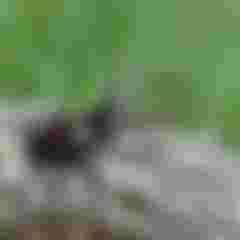
General description
The Latin name of this species comes from the word cervus which means deer. It feeds on the remains of trees. Jelenak is one of the largest insects in Europe, which is threatened with extinction. They feed on wood sap and are insignificant as pests. The deer (Lucanus cervus) is our largest hard-winged insect. Most of the species of this family (and there are more than 900 of them) have even more strongly developed upper claws in both sexes. The color is dark brown (almost black), and the cover is chestnut and quite large (body length is about 3 cm), and the male and female differ in that the male has a stronger upper jaw, large pliers ("horns") that serve him for fight rivals. Male pliers can be as long as the whole body. They are actually what teeth are for other animals. Its body size is larger than 7.5 cm, of which one third in males are pliers. On the inside, the pliers are serrated at the top and resemble deer antlers, after which this species, as well as the whole family, got its name. On the head are ten-membered tentacles that end in leaf-like extensions at the top. Males are more prone to flying than females. The female is somewhat smaller and does not have such developed pincers, although she bites strongly with them. Its larvae are C-shaped. Lucanus cervus is widespread in Central and Southern Europe and Asia Minor. It lives in oak forests, in holes of old trees and stumps.
THE MOST FAMOUS SPECIES
The most famous is certainly Lucanus cervus L. - deer and Dorcus parallelopipedus - little deer. The common or real deer is a black-brown beetle, which without a mandible reaches a length of 6 cm, and the mandibles are 2 cm long. The female is black, with much shorter mandibles. They appear in the second half of May and April. The larvae live mostly in old, hollow, dry oaks. The little deer is dull black and is about 2.5 cm long. It is common in forests, under the bark of trees. The larvae live in rotten wood of beech, linden, oak, walnut, etc.
Nutrition
It feeds on the remains of trees (at night it goes out and takes the fallen bark of trees). Adults live only a few months and feed on nectar and sap of trees. The larvae feed on rotten wood, and there are combs on their feet that serve to communicate with other larvae. These beetles depend on rotten trees, since the deer larva should spend 6-8 years in rotten trunks, feeding on their rot. Its larva lives only a few years in rotten oak stumps, where it drills corridors and feeds on plant juices. Deer feed on magpies, chickens, badgers, foxes, hedgehogs, cats and woodpeckers. However, their biggest enemy is the man who is destroying their habitats.
Reproduction
Adult males appear at the end of May and are most active in the evening. Females lay eggs in rotten trees or in the ground next to them. The larvae are C-shaped. It takes 4 to 6 years for the larvae to turn into pupae, most often in fallen oak trees, in the root spaces of deciduous trees. . After that, they hatch in larger cavities of the tree where they fully develop by autumn, but the pupae do not leave until the summer of next year. The pupae live in the ground for about 3 months, and then in the summer they turn into adults that take off to mate. during the day it sucks the sap of the oak, and at night it chases the females for mating. Since females can fly, they fly at dusk, but only over short distances, they need to find males that are relatively close to them.
INTERESTING FACTS
Survival By exploiting forests, old trees are being destroyed, so there are fewer and fewer opportunities for the survival of this beautiful insect. Therefore, it is protected in many countries and is listed as an endangered species on the list of international organizations, e.g. Berne Convention 1982, etc. Jelenak is one of the largest insects in Europe, which is threatened with extinction. Deer plays a key role in the initial fermentation and decomposition of decaying wood. In natural forest ecosystems, rotting trees make a constant gap in development, and can cause even catastrophic phenomena, such as fires and storms. There is a large amount of burned and weakened trees in the burned area, which greatly help the survival of the deer. Since man started exploiting the forest, the average age of trees, tree species and the availability of rotten trunks in the forest have been significantly disturbed. As a result, the number of many insects that live from trees has drastically decreased, and a large number of living beings are endangered as a result.

আমি জানি না যে তারা বিলুপ্তির ঝুঁকিতে রয়েছে।